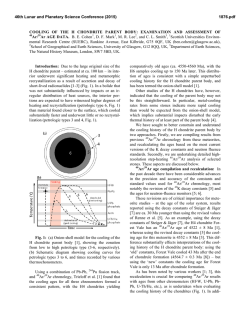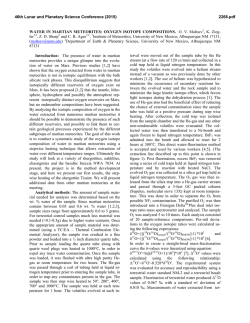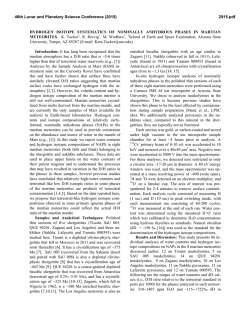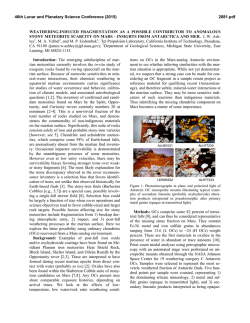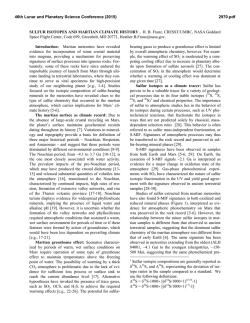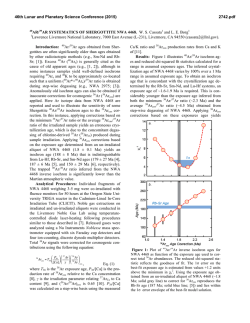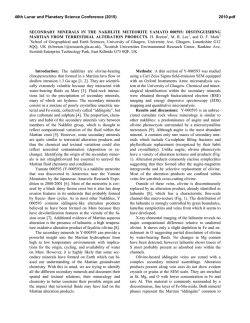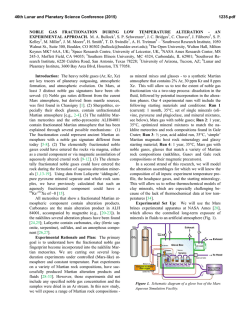
MARTIAN IGNEOUS ACTIVITY AND FLUID
46th Lunar and Planetary Science Conference (2015) 1886.pdf MARTIAN IGNEOUS ACTIVITY AND FLUID-BASED ALTERATION: CHRONOLOGICAL CONSTRAINTS FROM 40Ar/39Ar ANALYSES OF THE NAKHLITES. B. E. Cohen1, D. F. Mark1, T. Tomkinson1, M. R. Lee2, and C. L. Smith3, 1Scottish Universities Environmental Research Centre (SUERC), Rankine Avenue, East Kilbride, G75 0QF, UK ([email protected]), 2School of Geographical and Earth Sciences, University of Glasgow, G12 8QQ, UK, 3Department of Earth Sciences, The Natural History Museum, London, SW7 5BD, UK. Introduction: The nakhlites are a group of mafic igneous rocks that crystallized on Mars at ca. 1.3-1.4 Ga [1-5]. They are amongst the least shocked Martian meteorites, with cumulate igneous textures (Fig. 1) and thus provide a crucial record of igneous activity and fluid-rock interaction on the red planet. Crystallization of the nakhlites. Understanding the original structure of the nakhlite source is crucial for using these stones to explore Martian igneous processes. In particular, are the different nakhlites from a single thick and differentiated lava flow/sill [6; 7], or do they instead represent magmatically related – but distinct – flows/intrusions? If the various meteorites are derived from separate units, then there will be differences in crystallization ages within the nakhlite suite – which may be identified if these differences are sufficiently large relative to the attainable precision of radioisotopic dating techniques. Some studies [e.g., 5] appear to resolve age differences between different stones, and we aim to test the single vs. multiple unit hypotheses via application of detailed 40Ar/39Ar stepheating of six nakhlites. Alteration of the nakhlites, and the timing of waterrock interaction. In addition to primary magmatic minerals and glasses, the nakhlites contain secondary minerals including clays and carbonates that were precipitated by Martian aqueous fluids prior to impact ejection (Fig. 2) [8-10]. When did this alteration occur? As the clays contain potassium, they are amenable to K-Ar and 40Ar/39Ar dating. K-Ar data from Lafayette suggests the alteration phases formed between 0 to 670 Ma [11]. We consider further the timing of alteration using our 40Ar/39Ar data. Methods: We applied 40Ar/39Ar chronology to six meteorites: Lafayette, Nakhla, Yamato 000593, Yamato 000749, Northwest Africa 5790, and Miller Range 03346. These stones cover the mineralogical and chemical diversity within the nakhlite group, in particular spanning from the top to base of the accepted stratigraphic order for the nakhlites [6; 7]. Martian meteorites can contain diverse argon reservoirs [4], in particular: trapped Martian atmosphere, 40 Ar from radioactive decay of potassium from primary igneous phases, 40Ar from radioactive decay of potassium from Martian weathering products, and cosmogenic Ar. The Ar budget of these meteorites can be further complicated by loss of Ar due to impact ejec- tion, Earth atmospheric entry, and nuclear recoil (specifically 37Ar and 39Ar) due to the requirement to irradiate samples for 40Ar/39Ar dating. In an attempt to distinguish between the different reservoirs and characterize potential loss of Ar, we subjected groundmass separates to high-resolution heating schedules of between 43-45 steps (Fig. 3). Aliquots of clinopyroxene separates (12 steps) and olivine concentrates (10 steps) were also analyzed to understand the Ar budget of the main minerals within the nakhlites [4]. Samples were irradiated for 80 hours in the Cdlined TRIGA reactor, Oregon State University, and analyzed at SUERC on a MAP 215-50 spectrometer. Data were regressed using the protocol outlined by [4] using the decay constants and standard values of [12], and Martian atmospheric 40Ar/36Ar of 1900 [13]. Fig. 1: Transmitted-light image of Nakhla, acquired between crossed polarizers, showing fresh plagioclase crystals (center; dark grey laths) surrounded by pyroxene. Field of view is 0.4 mm. Fig. 2: Transmitted light image of Nakhla with veins of brown alteration phases (dominantly smectite and carbonates [10]) cutting across pyroxene crystals. Field of view is 0.4 mm. 46th Lunar and Planetary Science Conference (2015) Fig. 3: Incremental-heating data for groundmass aliquots of the nakhlite meteorites. Fig. 4: Expanded view of the previous diagram, showing the low-temperature steps. Results and discussion: 40Ar/39Ar data from the nakhlites have some broad similarities (Fig. 3). For all samples, the bulk of the gas released yields apparent ages of ~1.3 Ga, although the age spectra are not completely flat, reflecting unmixing of the diverse Ar reservoirs contained in the meteorites. Nevertheless, individual samples yield near-concordant analyses over considerable portions (~30-50%) of the 39Ar released (Fig. 3) enabling investigation of the age of igneous crystallization for each meteorite. These preliminary results indicate that all of the analyzed nakhlites have similar igneous crystallization ages, but there are differences between the stones that we will investigate further via additional interrogation of the data. The pyroxene and olivine analyses (not shown) yield similar 1.3 Ga apparent ages, albeit with lower precision due to the lower K contents of these phases. At high temperatures, all of the meteorites yield scattered results, with apparent ages that are much younger than 1.3 Ga. We interpret these hightemperature steps to represent recoil of 39Ar and 37Ar. Lafayette was most susceptible to nuclear recoil, while Yamato 000749 was least susceptible (Fig. 3). 1886.pdf Timing of alteration. The low-temperature steps yield noticeable differences amongst the meteorites (Fig. 4). Nakhla has low-temperature steps of ~1.1 Ga, while Yamato 000593 and NWA 5790 yield apparent ages as young as ~700 Ma. The young signal is particularly strong for NWA 5790, influencing the first ~40% of the gas released (Fig. 3). On the other hand, Lafayette and Yamato 000749 have low-temperature steps with apparent ages of ~1.3 Ga, similar to the igneous crystallization ages, while MIL 03346 has lowtemperature steps that approach 1.5 Ga (Fig. 4). These varied results demonstrate substantial lowtemperature Ar heterogeneity amongst the nakhlite analyses. The differences are unlikely to be due to recoil, as the samples with large amounts of recoil at high temperatures (especially Lafayette) do not have corresponding young ages at low temperatures. Instead, by analogy with 40Ar/39Ar analyses of altered terrestrial basalts [14], we interpret the young lowtemperature steps as being influenced by the Ar budget of the Martian aqueous alteration, with the detailed heating schedules allowing separation of the lowtemperature alteration signal from the hightemperature igneous signal [15]. We aim to test this scenario further via 40Ar/39Ar dating of alteration materials from the nakhlites that were encapsulated prior to irradiation to prevent loss of 37Ar and 39Ar due to nuclear recoil. References: [1] Nyquist L. E. et al. (2001) Space Sci. Rev., 96, 105-164. [2] Swindle T. D., and Olson E. K. (2004) Meteoritics & Planet. Sci., 39, 755-766. [3] Park J. et al. (2009) GCA, 73, 2177-2189. [4] Cassata W. S. et al. (2010) GCA, 74, 6900-6920. [5] Korochantseva E. V. et al. (2011) Meteoritics & Planet. Sci., 46, 1397-1417. [6] Mikouchi T. et al. (2012) LPS XLIII, Abstract #2363. [7] Mikouchi T. et al. (2006) LPS XXXVII, Abstract #1865. [8] Trieman A. H. et al. (1993) Meteoritics, 28, 86-97. [9] Gooding J. L. et al. (1991) Meteoritics, 26, 135–143. [10] Tomkinson T. et al. (2013) Nature Comm., 4:2662, 16. [11] Swindle T. D. et al. (2000) Meteoritics & Planet. Sci., 35, 107-115. [12] Renne P. R. et al. (2011) GCA, 75, 5097-5100. [13] Mahaffy P. R. et al. (2013) Science, 341, 263-266. [14] Foland K. A. et al. (1993) Chem. Geol., 107, 173-190. [15] VanLaningham S., and Mark D. F. (2011) GCA, 75, 2324-2335.
© Copyright 2026
